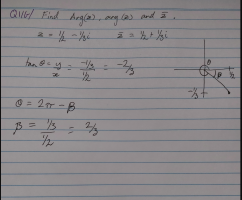Four Muffins
New member
- Joined
- Jun 29, 2022
- Messages
- 25
Hello. I'm not allowed to use a calculator to solve this, but I'm unable to use either of the methods covered in the unit to solve this problem.
The methods are using arctan rise over run, or to use a 'helper angle', but with either one I end up at the same spot. It is questions b I'm stuck on. Is this supposed to be a trick question that is unsolvable, or would I just leave the argument as arctan -2/3? I do notice that arctan 2/3 is very close to root3/3, but I don't understand if that is a coincidence or not.


The methods are using arctan rise over run, or to use a 'helper angle', but with either one I end up at the same spot. It is questions b I'm stuck on. Is this supposed to be a trick question that is unsolvable, or would I just leave the argument as arctan -2/3? I do notice that arctan 2/3 is very close to root3/3, but I don't understand if that is a coincidence or not.


